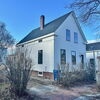
Processing Your Payment
Please do not leave this page until complete. This can take a few moments.
Higher ed gets ahead: Despite ups and downs of 30 years, Maine schools always eyed the future
 Provided RENDERING / UNIVERSITY OF SOUTHERN MAINE
The Crewe Center for the Arts, at USM’s Portland campus, is due to be completed for the fall 2025 semester.
Provided RENDERING / UNIVERSITY OF SOUTHERN MAINE
The Crewe Center for the Arts, at USM’s Portland campus, is due to be completed for the fall 2025 semester.
During the Great Recession of 2008-09, higher education institutions experienced layoffs, tuition hikes and budget freezes to make it through the economic decline.
But the institutions had an eye to a prosperous future.
At the height of the economic downturn, the University of Maine at Fort Kent launched a winter sports-management program to prepare students for careers at ski areas. Husson University aspired to launch a law school. The University of Maine’s Advanced Structures & Composites Center spun out a private company to use composite technology in bridge construction.
Northern Maine Community College welcomed its biggest incoming class in memory — a good news-bad news development because many students were Aroostook County workers laid off from paper mills and the lumber industry. The Augusta-based Maine Coalition for Excellence in Education and a group of business and other partners launched the Prepare Maine Initiative, aimed at strengthening the state’s educational system and workforce training.

History in the making
Those kinds of optimistic developments turned things around. In recent years, institutions have undertaken a wealth of facility and program advancements. Here’s a sampling.
The University of Maine was established in 1862 as the Maine College of Agriculture and the Mechanic Arts under the provisions of the Morrill Act, approved by President Abraham Lincoln. The institution opened in 1868 with 12 students. It became the University of Maine in 1897 and now has 110,000 alumni worldwide.
In 2014, UMaine’s Aroostook Farm in Presque Isle celebrated 100 years of service to Maine’s potato industry. In 2015, the Darling Marine Center in Walpole celebrated 50 years.
Since 1996, new facilities have included the Advanced Structures & Composites Center, Bryand Global Sciences Center, Frederick E. Hutchinson Center in Belfast, Museum of Art in Bangor, Foster Center for Innovation, New Balance Student Recreation Center, Innovative Media, Research and Commercialization Center and Wyeth Family Studio Art Center, and Harold Alfond W2 Ocean Engineering Laboratory and Advanced Manufacturing Laboratory.
In the past two years, the Orono campus unveiled the $78 million E. James and Eileen P. Ferland Engineering Education and Design Center. A green engineering and materials building, called Factory for the Future, will be the next project for the Orono campus.
In 2023, Maine Law moved from a 1960s-era building to a renovated 64,000-square-foot space at 300 Fore St. in Portland, close to state and federal courts and several law firms and under the same roof as UMaine’s Graduate and Professional Center, Graduate School of Business, Portland Gateway, University of Maine Foundation and University of Southern Maine’s Muskie School of Public Service.
University of Southern Maine, created in 1971, had recent revamps with the $63 million, 40,000-square-foot Crewe Center for the Arts in Portland, slated for completion in 2025. The McGoldrick Center for Career & Student Success in Portland includes spaces for student leadership, diversity, scholarship and government. The adjacent Portland Commons Residence Hall is USM’s first on-campus dormitory. Both are built to LEED Gold certification.
University of New England’s College of Osteopathic Medicine outgrew its Biddeford location and began construction in 2022 on the 110,000-square-foot Harold and Bibby Alfond Center for Health Sciences in Portland, to bring together UNE’s health professions programs into an interprofessional learning community. In 2023, UNE created a College of Business and a School of Education within the College of Arts and Sciences.
Husson University in Bangor dates to 1898. In 2021, Husson opened Harold Alfond Hall for the College of Business, including the Ronan Center for Financial Technology and the iEX Center equipped with an extended reality lab.
Bates College in Lewiston dates to 1855. In 2021, its 65,000-square-foot Bonney Science Center opened as the centerpiece of a $75 million project to upgrade science teaching and research facilities.
Unity Environmental University, dating to 1965, moved in 2021 to Pineland Farms in New Gloucester and expanded remote education programming.
Founded in 1894 in Waterville, Thomas College underwent moves and expansions through the decades. In the 1980s, it established a Computer Information Systems major, an internship program and Portland Center. Developments through the 2000s included Laurette Ayotte Auditorium, partnerships with the Maine Criminal Justice Academy and Putnam Investments, renovations to the Dining Center and opening a 100-bed student residence. The Harold Alfond Athletic Center opened in 2006, followed by the George and Marty Spann Student Commons, Harold Alfond Academic Center, Henry and Ellen Hinman Hall, Harold Alfond Institute for Business Innovation, Peter & Paula Lunder School of Education and an 18,000-square-foot athletic facility.

Since its founding in 1794, Bowdoin College in Brunswick has reshaped its footprint multiple times. Its first building, Massachusetts Hall, originally held the entire college. For a short while, Bowdoin was home to the Medical School of Maine. Bowdoin became carbon neutral in 2018. In 2022, innovative mass timber products helped build Barry Mills Hall and the John and Lile Gibbons Center for Arctic Studies.
Founded in 1813, Colby College in Waterville has 16 LEED-certified buildings and spaces and a 5,300-panel solar installation. In 2020, it opened the 350,000-square-foot Harold Alfond Athletics and Recreation Center. Colby and Waterville Creates commissioned the Paul J. Schupf Art Center, which opened in 2022. This year, Colby received $50 million from the Lunder Foundation to expand the school’s financial aid program.
Founded in 1969, College of the Atlantic in Bar Harbor became the first carbon-neutral college in the U.S. in 2007. Recent developments include the Davis Center for Human Ecology, using mass timber construction, solar, wood fiber insulation and triple-insulated—COA’s first academic building since the early 1990s. A new dormitory is designed to passive house principles.
Community colleges
Maine’s community colleges started as vocational technical institutes. The 1980s brought a name change to technical colleges and bonding for capital improvements. The institutes became community colleges in 2002. The Maine Community College System was established in 2003, followed by capital upgrades, program and student support expansions.
Developments in recent years include the 2021 launch of the Harold Alfond Center for the Advancement of Maine’s Workforce. Southern Maine Community College in South Portland splashed a new marine science training vessel and plan to start a mobile learning lab van for STEM training and a state-of-the-art health care simulation lab.














0 Comments